Unitron Hearing UWBTE Hearing Aid User Manual 29 5452 02 conNT BTEgd eng
Unitron Hearing, Inc. Hearing Aid 29 5452 02 conNT BTEgd eng
User manual

Passport™
BTE Guide

Table of Contents
Your Passport™ Hearing Instruments ............................1
Practical Solutions to Everyday Problems ......................2
Getting the Most Out of Your Passport™ Hearing
Instruments..................................................................3
Using the Passport™ BTE Guide....................................4
Putting Your Passport™ Hearing Instruments on Your
Ears ..............................................................................6
Turning Your Passport™ Hearing Instruments
On and Off ...................................................................8
Feedback-Free Listening .................................................9
Replacing the Battery....................................................10
Operating Instructions ..................................................12
Assistive Listening Devices...........................................23
Caring for Your Passport™ Hearing Instruments.........25
Cleaning Your Passport™ Hearing Instruments...........27
Warnings.......................................................................30
Troubleshooting Guide .................................................32
Warning to Hearing Instrument Dispensers ................35

1
Your Passport™ Hearing Instruments
Hearing Healthcare Professional: _______________________
__________________________________________________
Telephone: _________________________________________
Model: ____________________________________________
Serial Number:______________________________________
Replacement Batteries: Size 13
Warranty: __________________________________________
Program 1 is the Automatic Program
Program 2 is the manual program for: __________________
Program 3 is the manual program for: __________________
Program 4 is the manual program for: __________________
Date of Purchase: ___________________________________

2
Practical Solutions to Everyday
Problems
Congratulations on choosing Passport™ BTE (Behind-
the-Ear) hearing instruments. For over 40 years,
Unitron has been committed to making life better for
people with hearing loss. This means a commitment
to developing high-quality hearing solutions that
incorporate special features to solve the everyday
problems and concerns you have with hearing loss
and hearing instruments.
Passport is a premium hearing instrument that
delivers superior sound quality, performance, and
extraordinary results. Passport BTE hearing
instruments offer wireless capability and access to
Bluetooth accessories. Passport’s automatic program
identifies your listening environment and
automatically determines hearing instrument settings
that are most effective for optimal listening as your
listening needs change throughout the day. Three
additional manual programs give you added flexibility
to meet your particular listening needs. Passport
offers you the ability to adjust your personal comfort
and clarity settings, giving you greater control of your
listening experience. Passport will also learn these
adjustments, leading to a more personalized hearing
instrument.

3
Getting the Most Out of Your
Passport™ Hearing Instruments
Adjusting to your new hearing instruments will take
some time. In the beginning it is important that you do
not use the hearing instruments for longer than is
comfortable. Depending on your previous experience
with hearing instruments, a few hours a day may be
enough and then you can increase wearing time
gradually. Once you have become accustomed to your
hearing instruments, you should wear them all day
everyday since frequent use will help you adapt to
your hearing instruments and enjoy their full benefits.
The quicker you get used to the everyday sounds
around you, the less you will notice that you are
wearing hearing instruments.
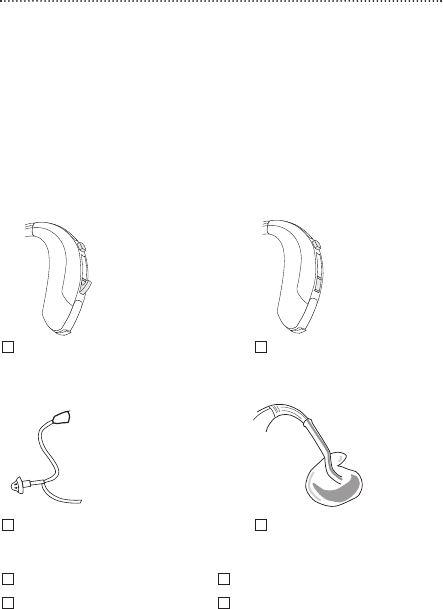
4
Using the Passport™ BTE Guide
Refer to the table of contents for a complete listing of
the topics covered in this guide.
There are different styles of BTEs available. The
diagrams below identify some of the components on
your hearing instruments. Have your hearing healthcare
professional place a check beside the diagram that best
describes your BTE style and attachment.
slim tube and dome earhook and earmold
BTE with volume control BTE without volume control
Hearing Instrument Style
Attachment Style (check one)
My hearing instrument has (check all that apply)
SmartFocus Program Button
Volume Control Push Button Volume Control
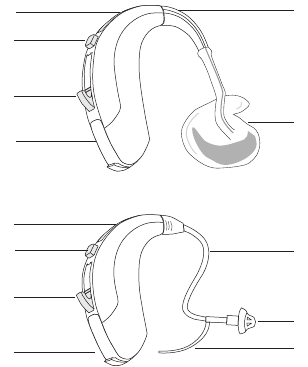
5
Legend
1 Earhook
2 Microphone and Microphone Shield
3 Program Button or Push Button Volume Control
(depending on your customized fitting)
4 Volume Control or SmartFocus
(depending on your customized fitting)
5 Battery Door/On & Off Switch
6 Slim Tube
7 Dome
8 Retention Piece
9 Earmold
1
2
3
4
4
59
6
8
2
3
5
7
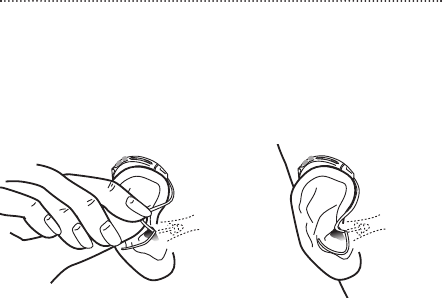
6
Putting Your Passport™ Hearing
Instruments on Your Ears
Your BTE hearing instrument may be color-coded red
for your right ear and blue for your left ear. This color
indicator is located on the bottom of the battery door
with a small colored dot.
BTEs with Slim Tubes
1. Hold the slim tube where it attaches to the dome
and gently push the dome into your ear canal. The
slim tube should lie flush against your head and not
stick out.
2. Place the hearing instrument over the top of your
ear.
3. Place the retention piece in your ear so it rests at
the bottom of the opening of your ear canal.
4. Repeat steps 1-3 for your other ear if you wear two
hearing instruments.

7
BTEs with Earhooks
1. Hold the ear mold between your thumb and index
finger. The opening should be pointing in towards
your ear canal with the BTE resting upwards over
the top of your ear. Carefully insert the earmold in
your ear. The earmold should fit into your ear
snugly and comfortably.
2. Place the hearing instrument over the top of your
ear.
3. Repeat steps 1-2 for your other ear if you wear two
hearing instruments.
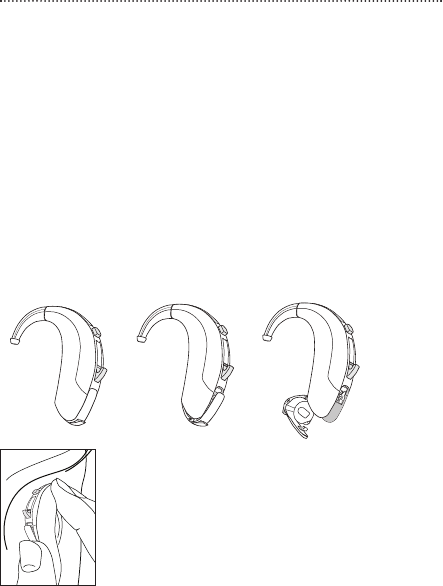
8
Turning Your Passport™ Hearing
Instruments On and Off
Your hearing instruments have a three-position
battery door that acts as an off/on switch and that
allows access to the battery compartment.
To turn the hearing instrument on, close the battery
door fully. Note: If the start up delay is activated, your
hearing instrument will not turn on for 10-15 seconds
after closing the battery door.
To turn the hearing instrument off, partially open the
battery door. This position also allows excess
moisture to vent away from the battery compartment.
To replace the hearing instrument battery, fully open
Note: When turning your hearing
instrument on and off, grasp the top and
bottom of the device with your index finger
and thumb. Use your thumb to open and
close the battery door.
on off open

9
the battery door for access to the battery
compartment.
Feedback-Free Listening
Your Passport hearing devices have an optional start
up delay that can be activated by your hearing
healthcare professional. If the start up delay is
activated, your hearing instruments will not turn on for
10-15 seconds after the battery door is closed fully.
The hearing instruments return to the start up delay
position each time you turn your hearing instruments
on. This allows you to insert your hearing instruments
without experiencing whistling.
If you wear hearing instruments now, you may have
experienced whistling from your hearing instruments
when you talk, chew, use the telephone or hug
someone. Passport’s feedback technology
dramatically reduces this uncomfortable whistling
before you or anyone else can perceive it.
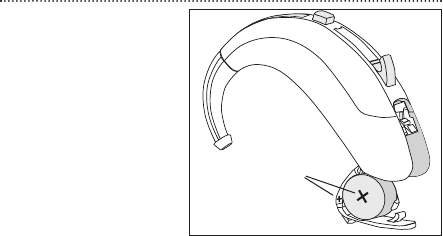
10
Replacing the Battery
1. Gently swing out
the battery door
with your
fingernail.
2. Grasp the battery
with your thumb
and index finger
and remove.
3. Insert the new
battery into the
battery compartment with the plus (+) sign on the
battery facing the same way as the plus (+) sign on
the edge of the battery door. This will ensure that
the battery door closes properly.
Note: If the battery is inserted incorrectly, the door
will not close.
4. Close the battery door.
Low Battery Warning
When you hear two long beeps, your hearing devices
are warning you that their batteries are low. You will
hear the warning approximately every 30 minutes
until you change the batteries or the batteries die.
After the first warning, you may experience some
reduction in sound quality. This is normal and can be
Plus (+) Signs
11
remedied by inserting fresh batteries in the hearing
devices. If you prefer, your hearing healthcare
professional can change the pitch and loudness of the
low battery beep or turn it off entirely.
Caring for Batteries
• Always discard batteries carefully.
• To prolong battery life, remember to turn your
hearing devices off when not in use.
• Remove the batteries and keep the battery door
open while hearing devices are not in use. This will
allow internal moisture to evaporate.
Battery Warnings
• Never leave hearing devices or batteries where
small children and pets can reach them.
• Never put hearing devices or batteries in your
mouth. If a hearing device or battery is swallowed,
call a physician immediately.

12
Operating Instructions
Changing Programs on Your Passport™
Hearing Instruments
Your Passport hearing instruments have an automatic
program and up to three additional manual programs.
Passport’s automatic program will satisfy most of your
listening needs by adjusting to different listening
environments without requiring manual adjustments.
Up to three additional manual programs can be
individually tailored by your hearing healthcare
professional to meet your particular listening needs.
Your hearing instruments may come equipped with a
push button which has been set for switching
between programs or adjusting your volume. This
push button could also be disabled by your hearing
healthcare professional. If you have an active push
button program control, each time you push the
button, you will move to a new program. The hearing
instrument can be set so that by pressing the push
button on one hearing instrument, both will be
adjusted.
Your Passport hearing instruments may also come
with an optional remote control which allows you to
switch between different listening programs. Ask your
hearing healthcare professional for more information
on the remote control.

13
There is also an optional uDirect accessory which
gives you connectivity to Bluetooth devices (ie. cell
phones, computers). With the simple push of the
uDirect button, you can enjoy hands-free use of your
cell phone. Ask your hearing healthcare professional
for more information.
Program Beeps
Your hearing devices beep to indicate which program
you are in (i.e. one beep for program 1, two beeps for
program 2, etc.) If you prefer, your hearing healthcare
professional can adjust the pitch and loudness of the
program beep or turn it off entirely.
duoLink
By pressing the push button on only one hearing
instrument, you can adjust both instruments
Program 1 (e.g. Automatic Program) 1 beep
Program 2 (e.g. Group/Party Noise) 2 beeps
Program 3 (e.g. Easy-t/Telephone) 3 beeps
Program 4 (e.g. Music) 4 beeps
Easy-t/Telephone short melody
Easy-DAI short melody
duoLink beeps the same as
feature being adjusted
14
simultaneously if this feature has been enabled by
your hearing healthcare professional.
Adjusting the Volume
The volume on your hearing instruments adjusts
automatically in response to the loud or quiet sounds
around you. Your hearing instruments are set to your
ideal volume by default. Your ideal volume is indicated
by 1 beep. If you have a push button volume control or
a volume control lever, you can further adjust the
volume. Before adjusting the volume on your hearing
instruments, secure the device on your ear with you
thumb and middle finger. Then using your index
finger, adjust the volume level with the volume control
lever or push button.
Your Passport hearing instruments will learn your
volume control adjustments while the hearing
instruments are set to the automatic program, if this
feature has been enabled by your hearing healthcare
professional. Over time, the hearing instruments will
adjust the default volume settings in the automatic
program to the levels that you typically use.
Your Passport hearing instruments may also come
with an optional remote control which allows you to
adjust your volume levels. Ask your hearing
healthcare professional for more information on the
remote control.

15
Push Button Volume Control
If your push button has been configured as a volume
control, you can adjust the volume level by pushing
the button. Note that your volume control may be
disabled by your hearing healthcare professional and,
therefore, could be inactive.
As you change the volume level, your hearing
instruments will beep. Please refer to the chart below
to learn more about the different volume beeps.
Your hearing healthcare professional can help you
identify your different push button volume control
settings. If you prefer, your hearing healthcare
professional can adjust the pitch and loudness of the
push button volume control beeps or turn them off
entirely.
Volume Control Lever
If the lever has been configured as a volume control,
you can adjust the loudness of your hearing
instruments by pushing the volume control lever up to
increase the loudness and pressing the volume
Volume Setting Beeps
Ideal volume level 1 beep
Increased loudness 1 beep + 1 high-pitched beep
Decreased loudness 1 beep + 1 low-pitched beep

16
control lever down to decrease the loudness. Note
that your volume control may be disabled by your
hearing healthcare professional and, therefore, could
be inactive.
As you change the volume level, your hearing
instruments will beep. Please refer to the chart below
to learn more about the different volume beeps.
Your hearing healthcare professional can help you
identify your different volume control settings. If you
prefer, your hearing healthcare professional can
adjust the pitch and loudness of the volume control
beeps or turn them off entirely.
Adjusting the SmartFocus
With a Passport hearing instrument, you can also
manage the levels of speech and background noise in
your listening environment via the SmartFocus. This
control provides an additional sound refinement
option beyond a traditional volume control. If your
hearing healthcare professional has enabled this
option, you can adjust your SmartFocus control to
Volume Setting Beep
Ideal volume level 1 beep
Maximum volume level 2 beeps
Minimum volume level 2 beeps
17
emphasize comfort or clarity using the rotary dial on
your hearing instruments. Before adjusting the comfort
or clarity on your hearing instruments, secure the
device on your ear with your thumb and middle finger.
Then using your index finger, adjust the SmartFocus
level with the lever.
Your Passport hearing instruments will learn your
SmartFocus comfort and clarity settings while the
hearing instruments are set to the automatic program;
if this feature has been enabled by your hearing
healthcare professional. Over time, the hearing
instruments will adjust the pre-programmed
SmartFocus settings to your preferred levels.
Your Passport hearing instruments may also come with
an optional remote control which allows you to adjust
your SmartFocus comfort and clarity levels. Ask your
hearing healthcare professional for more information
on the remote control.
SmartFocus
If the lever has been configured as a SmartFocus, push
the lever up to improve the clarity of sounds in front of
you, such as speech. For greater overall listening
comfort in noisy listening situations, press the lever
down.
As you change the SmartFocus level, your hearing
instruments will beep. Please refer to the chart below

18
to learn more about the different comfort-clarity
beeps.
Note: As the SmartFocus moves toward the midpoint
section, the effect on sound is minimized.
Your hearing healthcare professional can help you
identify your different SmartFocus settings. If you
prefer, your hearing healthcare professional can
adjust the pitch and loudness of the SmartFocus
beeps or turn them off entirely.
Listening in Windy Environments
Passport’s wind noise manager will engage
automatically based on whether wind conditions are
moderate or high. When the wind noise manager is
engaged, sounds such as speech may become quieter
because the wind noise manager is working to reduce
the loud noise produced by the wind. When you are
no longer in a windy environment, the wind noise
manager will not be active and desirable sounds, such
as speech, will once again become louder.
SmartFocus Setting Beep
Maximum sound clarity level 2 beeps
Maximum listening comfort level 2 beeps
Ideal comfort and clarity level 1 beep
19
Listening in Quiet and Noisy Environments
Your Passport hearing instruments may have a
directional microphone system to meet your listening
needs in different environments. The directional
system focuses on sounds in front of you (i.e., speech)
while reducing sounds from the sides or behind you
(i.e., noise). The directional system can be set to track
moving noise sources and adapt to changing noise
levels so that background noise is reduced. Your
hearing healthcare professional can tell you how your
directional system has been customized for you and
which listening programs have the directional
microphones activated.
In addition, Passport contains antiShock™ technology
that identifies and minimizes sudden impulse sounds
that many hearing device wearers find irritatingly loud
such as slamming doors or clattering dishes. This
technology is designed to increase listening comfort in
adverse listening situations without impacting sound
quality or your ability to understand conversations.
Replacing the Microphone Protectors
Your Passport hearing devices have a shield to protect
the microphones from dirt and debris. Debris on the
microphone protector reduces the sound quality of
the instrument. You should have the microphone
protectors replaced by your hearing healthcare
20
professional approximately every three months to
ensure optimal sound quality.
Using Passport™ with the Telephone
Passport has the ability, depending on hearing loss,
vent size and style of hearing device to provide
feedback-free phone use without program changes.
For many wearers this means, when the phone rings,
all you have to do is pick up the telephone and hold it
to your ear normally. In some situations when using a
cell phone, you may experience digital interference
that sounds like static, buzzing or beeping. If you
experience interference, increase the distance
between your hearing instrument and the phone
receiver.
Easy-t for the Telephone or Cell/Mobile Phone
Passport comes equipped with easy-t (automatic
telephone switch) that can help you listen on the
telephone. Easy-t automatically switches your hearing
instrument into a telephone listening mode with
hearing instrument compatible phones. You will hear a
short melody to indicate you are in the telephone
(easy-t) program. If your phone is hearing instrument
compatible, it will have a magnetic coil and easy-t will
activate automatically when the telephone is held to
the ear. Once the telephone is removed from the ear,
21
the hearing instrument will switch back to the normal
listening mode. Since the location and strength of the
magnetic coil varies among phone manufacturers, it
may be necessary to move the telephone receiver
slightly to find the best reception.
If the hearing instrument does not switch to telephone
program automatically when the telephone receiver is
placed in proximity, the magnet for easy-t hearing
instruments should be attached to the telephone
receiver. The magnet is designed to strengthen the
magnetic field at the ear piece of hearing instrument
compatible telephones.
Depending on the programming provided by your
Hearing Healthcare Professional, easy-t may also be
equipped to automatically adjust the hearing
instrument settings on your non-phone ear to assist
with telephone situations (eg. reduce loudness and
resulting interference of environmental sounds in non-
phone ear).
To affix the easy-t magnet:
1. Clean the telephone receiver.
2. Hold the magnet near the “listening end” of your
telephone receiver and release it (Figure 1). The
magnet will flip to the appropriate side and seek
the optimal position on the telephone receiver.

22
3. Place the double-sided tape in this optimal position
on the telephone receiver (Figure 2) and attach the
magnet to the tape (Figure 3).
Warnings
• Be sure the magnet is securely affixed to the
telephone.
• Keep loose magnets out of reach of children and
pets.
• If the magnet falls into your ear, contact your
hearing healthcare professional.
• If the magnet is swallowed, contact your physician
immediately.
• The magnet may affect some medical devices or
electronic systems. Always keep the magnet (or the
telephone equipped with the magnet) at least 30
cm (12”) away from pacemakers, credit cards,
floppy disks or other magnetically sensitive
devices.
Figure 1 Figure 2 Figure 3

23
• Too high distortion during dialing or phoning may
mean that the phone handset is stressed by the
magnet. To avoid any damage, please move the
magnet to another place on the telephone receiver.
Assistive Listening Devices
Listening in Public Places
Passport’s optional telecoil can also help you listen in
public places equipped with telecoil compatible
assistive listening devices such as a loop system. If
your hearing devices do not operate when the telecoil
is on, the loop system may not be operating or you
may be in a “dead” spot. Try positioning yourself in a
different part of the looped area or return your
hearing devices to the microphone position and sit as
close to the speaker as possible.
Connecting to External Audio Sources
Your Passport hearing instruments may
feature optional direct audio input (DAI) to
connect to other audio sources such as a
stereo or television. Easy-DAI
automatically selects your direct audio
input program when a device such as your
stereo, television, etc. is connected to your
hearing instruments. A short melody will play to
24
confirm that easy-DAI is active. When you disconnect
from the device, your hearing instruments will return to
the program you were in before connecting your device.
You will need to purchase the direct audio input system
and a connector cord from your hearing healthcare
professional before you can connect to external audio
sources.
You can also connect to external audio sources by using
the uDirect optional wireless accessory. Ask your Hearing
Healthcare Professional for information about uDirect.
Listening Over Distance
Your Passport hearing devices may be compatible with
Phonak’s MicroLink™ Receiver Module, a wireless FM
system that improves listening over distance. The MLx
FM receiver module connects to the direct audio input
system and is powered by the hearing device battery.
A single MLx can also be plugged into the uDirect,
allowing the FM signal microphone to be sent
wirelessly to your hearing instruments. Ask you
hearing healthcare professional for more information
about uDirect.
Using FM and Infrared Systems
Some FM systems consist of a cord (i.e. teleloop) worn
around the neck, which is connected to the FM receiver
worn on a belt or in a shirt pocket. To listen through
25
the FM system, select the telecoil program and turn on
the FM receiver. To keep the signal clear, you may need
to adjust the volume control on your hearing
instruments, as well as on the FM receiver.
With some infrared systems you may need to remove
your hearing instruments and wear the system’s
headset receiver. If the volume on the infrared receiver
is not loud enough, use your hearing instruments
instead.
See also “Connecting to External Audio Sources.”
uDirect
Your Passport hearing devices may come with an
optional uDirect™, a connectivity device between your
hearing instruments and Bluetooth-enabled cell phones,
or a standard audio jack. Ask your hearing healthcare
professional for more information on uDirect.
Your Passport hearing instruments may also come with
an optional uDirect accessory. uDirect is a connectivity
device that is worn around your neck, and provides
wireless transmission of various sound sources directly
to your hearing instruments, thereby helping to reduce
impact of background noise on the signals you are
hearing. uDirect provides easy hands-free access to
clear audio signals from Bluetooth-enabled devices
such as cell phones or to other audio sources using a
standard audio jack plug-in.

26
Caring for Your Passport™ Hearing
Instruments
• Open the battery door when not in use.
• Always remove your hearing instruments when
using hair care products. The hearing instruments
can become clogged and cease to function
properly.
• Do not wear your hearing devices in the bath or
shower or immerse them in water.
• If your hearing instruments do become wet, do not
attempt to dry them in an oven or microwave. Do
not adjust any controls. Open the battery doors
immediately, and allow your hearing instruments to
dry naturally for 24 hours.
• Protect your hearing instruments from excessive
heat (hair dryer, vehicle glove box or dashboard).
• Regular use of a dehumidifier, such as a Dri-Aid kit,
can help prevent corrosion and prolong the life of
your hearing instruments. See your hearing
healthcare professional for more information.
• Do not drop your hearing instruments or knock
them against hard surfaces.
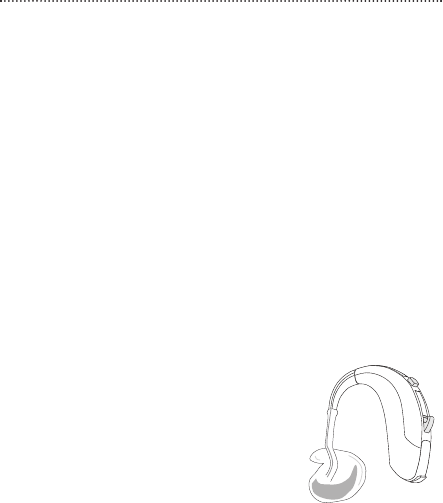
27
Cleaning Your Passport™ Hearing
Instruments
Ear wax is natural and common. Ensuring your hearing
instruments, earmolds and domes are free of ear wax
is an important step in your daily cleaning and
maintenance routine.
• Never use alcohol to clean your hearing devices,
earmolds or domes.
• Do not use sharp tools to dislodge ear wax.
Sticking household items into your hearing devices
or earmolds can seriously damage them.
Cleaning the Earmolds and Domes
Ensure your earmolds and domes are free of ear wax
and moisture.
BTEs with Earhooks and Earmolds
If your Passport hearing devices
have earhooks (see “Using the
Passport BTE Guide”), your hearing
healthcare professional fit you with
customized earmolds (see “Using
the Passport BTE Guide”.) Earmolds
send amplified sound from the
hearing devices into the ears. They must fit into your
ears snugly and comfortably. If amplified sound leaks
out of your ear, you may hear whistling.
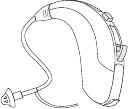
28
Always ensure earmolds are clean and free of ear wax
and moisture. Do not use alcohol to clean your
earmolds. If the earmolds become plugged, clear the
opening with a wax loop or pipe cleaner. If your
physician prescribes eardrops, clean any moisture
that may get into the earmolds or tubing to prevent
plugging.
Cleaning the Earmolds
If the earmolds attach to an earhook and they require
further cleaning, disconnect the plastic tube from the
hook of the hearing devices. Wash only the earmolds
in warm water with a mild soap. Rinse them with cool
water and allow them to dry overnight. Make sure the
earmold tubes are dry before reconnecting them to
each hook on your hearing devices.
BTEs with Slim Tubes and Domes
If your hearing instruments have
slim tubes (see “Using the Passport
BTE Guide”), you need to ensure
that the tubes and domes are free of
ear wax and moisture. You should
have the slim tubes and domes
replaced by your hearing healthcare professional
approximately every three to six months or when they
become stiff or brittle. Clean the domes daily with a
damp cloth. You should also clean the slim tubes
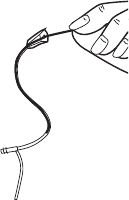
29
periodically, with the cleaning pin provided, when you
begin to notice debris in and around the tubes.
Cleaning the Slim Tubes and Domes:
1. Hold the slim tube in one hand and the hearing
instrument in the other hand.
2. Gently turn the hearing instrument until it detaches
from the slim tube.
3. Use a damp cloth to clean the outside of the slim
tube and the dome.
4 Remove the dome from the slim tube.
5. Using the black cleaning pin
provided in the kit, gently insert
the cleaning pin where the slim
tube attaches to the hearing
instrument and push the pin all
the way through the tube.
Note: The slim tubes and domes
should never be rinsed or
submerged in water as water drops
may become lodged in the tube, block sound or
damage the electrical components of the hearing
instrument.
6. Once the slim tube has been cleaned, reattach it by
gently turning the hearing instrument onto the slim
tube. Reattach the dome to the slim tube.

30
Warnings
• Hearing devices should only be used as directed by
your physician or hearing healthcare professional.
• Hearing devices will not restore normal hearing and
will not prevent or improve a hearing impairment
resulting from organic conditions.
• Do not use your hearing devices in explosion
hazard areas.
• Allergic reactions to hearing instruments are unlikely.
However, if you experience itching, redness,
soreness, inflammation or a burning sensation in or
around your ears, inform your hearing healthcare
professional and contact your physician.
• In the unlikely case that any parts remain in the ear
canal after the removal of the hearing instrument,
contact a physician immediately.
• Remove your hearing devices for CT and MRI scans
or for other electromagnetic procedures.
• Only plug the DAI cables into devices that produce
safe voltages of less than 3 volts.
• Special care should be exercised in wearing
hearing devices when maximum sound pressure
levels exceed 132 decibels. There may be a risk of
impairing your remaining hearing. Speak with your
hearing healthcare professional to ensure the
maximum output of your hearing devices is
suitable for your particular hearing loss.
31
Note to hearing healthcare professional
Domes should never be fitted on patients with
perforated eardrums, exposed middle ear cavities, or
surgically altered ear canals. In the case of such a
condition, we recommend to use a customized ear mold.
Precautions
• The use of hearing instruments is only part of
hearing rehabilitation; auditory training and lip
reading instruction may be required as well.
• In most cases, infrequent use of hearing
instruments does not provide full benefit. Once you
have become accustomed to your hearing devices,
wear your hearing devices everyday all day.
• Your hearing instruments use the most modern
components to provide the best possible sound
quality in every listening situation. However,
communication devices such as digital cell phones
can create interference (a buzzing sound) in
hearing instruments. If you experience interference
from a cell phone being used close by, you can
minimize this interference in a number of ways.
Switch your hearing instruments to another
program, turn your head in a different direction or
locate the cell phone and move away from it.
Labeling
The serial number and year of manufacture are
located inside the battery door.

32
Troubleshooting Guide
CAUSE POSSIBLE REMEDY
No sound
• Not turned on
• Low/dead battery
• Poor battery contact
• Battery upside down
• Earmolds/slim tubes/
domes blocked with
ear wax
• Plugged microphone
protector
Not loud enough
• Low volume
• Low battery
• Earmolds/slim tubes/
domes not inserted
properly
• Change in hearing
• Earmolds/slim tubes/
domes blocked with
ear wax
• Plugged microphone
protector
• Turn on
• Replace battery
• Consult your hearing healthcare professional
• Insert battery plus (+) side up
• Clean earmolds/domes. See “Cleaning the
Earmolds and Domes”. Use cleaning pin to
dislodge ear wax in slim tubes. Consult your
hearing healthcare professional.
• Consult your hearing healthcare
professional
• Turn up volume; see hearing healthcare
professional for models without a manual
volume control or if problem persists.
• Replace battery
• See “Putting Your Yuu Hearing Instruments
on Your Ears”. Reinsert carefully.
• Consult your hearing healthcare professional
• Clean earmolds. See “Cleaning the Earmolds
and Domes”. Use cleaning pin to dislodge ear
wax in slim tubes. Consult your hearing
healthcare professional.
• Consult your hearing healthcare
professional

33
Intermittent
• Low battery
• Dirty battery contact
Two long beeps
• Low battery
Whistling
• Earmolds/slim tubes/
domes not inserted
properly
• Hand/clothing near ear
• Poorly fitting earmolds/
slim tubes/domes
Not clear, distorted
• Poorly fitting earmolds/
slim tubes
• Earmolds/slim tubes/
domes blocked with
ear wax
• Low battery
• Plugged microphone
protector
• Replace battery
• Consult your hearing healthcare professional
• Replace battery
• Remove and reinsert carefully
• Remove hand/clothing from ear
• Consult your hearing healthcare professional
• Consult your hearing healthcare professional
• Clean earmolds. See “Cleaning the Earmolds
and Domes”. Use cleaning pin to dislodge
ear wax in slim tubes. Consult your hearing
healthcare professional.
• Replace battery
• Consult your hearing healthcare
professional
CAUSE POSSIBLE REMEDY

34
Earmolds/slim tubes/domes falling out of ear
• Poorly fitting earmolds/
slim tubes/domes
• Earmolds/slim tubes/
domes not inserted
properly
Weak on the telephone
• Telephone not
positioned properly
• Hearing device requires
adjustment
For any problems not listed in the guide, contact your hearing healthcare
professional. If you do not have a hearing healthcare professional, please
contact the nearest office listed on the back page of this booklet.
• Consult your hearing healthcare
professional
• See “Putting Your Yuu Hearing Instruments
on Your Ears”. Reinsert carefully.
• Move telephone receiver around ear for
clearer signal. See “Using Yuu with the
Telephone” and “Easy-t for the Telephone
or Cell/Mobile Phone”.
• Consult your hearing healthcare
professional
CAUSE POSSIBLE REMEDY

35
Warning to Hearing Instrument
Dispensers
A hearing instrument dispenser should advise a
prospective hearing instrument user to consult promptly
with a licensed physician (preferably an ear specialist)
before dispensing a hearing instrument if the hearing
instrument dispenser determines through inquiry, actual
observation, or review of any other available
information concerning the prospective user, that the
prospective user has any of the following conditions: (i)
Visible congenital or traumatic deformity of the ear. (ii)
History of active drainage from the ear within the
previous 90 days. (iii) History of sudden or rapidly
progressive hearing loss within the previous 90 days.
(iv) Acute or chronic dizziness. (v) Unilateral hearing loss
of sudden or recent onset within the previous 90 days.
(vi) Audiometric air-bone gap equal to or greater than 15
decibels at 500 hertz (Hz), 1,000 Hz, and 2,000 Hz. (vii)
Visible evidence of significant cerumen accumulation or
a foreign body in the ear canal. (viii) Pain or discomfort
in the ear. Special care should be exercised in selecting
and fitting a hearing instrument whose maximum sound
pressure level exceeds 132 decibels because there may
be risk of impairing the remaining hearing of the hearing
instrument user. [This provision is required only for
those hearing instruments with a maximum sound
pressure capability greater than 132 decibels (dB).]
Important Notice for Prospective Hearing
Instrument Users
Good health practice requires that a person with a
hearing loss have a medical evaluation by a licensed
physician (preferably a physician who specializes in
diseases of the ear) before purchasing a hearing
instrument.
Licensed physicians who specialize in diseases of the
ear are often referred to as otolaryngologists,
otologists or otorhinolaryngologists. The purpose of
medical evaluation is to assure that all medically
treatable conditions that may affect hearing are
identified and treated before the hearing instrument is
purchased. Following the medical evaluation, the
physician will give you a written statement that states
that your hearing loss has been medically evaluated
and that you may be considered a candidate for a
hearing instrument. The physician will refer you to an
audiologist or a hearing instrument dispenser, as
appropriate, for a hearing instrument evaluation. The
audiologist or hearing instrument dispenser will
conduct a hearing instrument evaluation to assess
your ability to hear with and without a hearing
instrument. The hearing instrument evaluation will
enable the audiologist or dispenser to select and fit a
hearing instrument to your individual needs. If you
have reservations about your ability to adapt to
36
amplification, you should inquire about the availability
of a trial-rental or purchase-option program. Many
hearing instrument dispensers now offer programs
that permit you to wear a hearing instrument for a
period of time for a nominal fee after which you may
decide if you want to purchase the hearing
instrument. Federal law restricts the sale of hearing
instruments to those individuals who have obtained a
medical evaluation from a licensed physician. Federal
law permits a fully informed adult to sign a waiver
statement declining the medical evaluation for
religious or personal beliefs that preclude
consultation with a physician. The exercise of such a
waiver is not in your best health interest and its use is
strongly discouraged.
Children With Hearing Loss
In addition to seeing a physician for a medical
evaluation, a child with a hearing loss should be
directed to an audiologist for evaluation and
rehabilitation since hearing loss may cause problems
in language development and the educational and
social growth of a child. An audiologist is qualified by
training and experience to assist in the evaluation and
rehabilitation of a child with a hearing loss.
37

38
Notices
Notice 1
This instrument is certified under:
FCC ID: VMY-UWBTE
IC: 2756A-UWBTE
This device complies with Part 15 of the FCC Rules and
with RSS-210 of Industry Canada. Operation is subject
to the following two conditions:
1) this device may not cause harmful interference, and
2) this device must accept any interference received,
including interference that may cause undesired
operation. Changes or modifications made to this
equipment not expressly approved by Phonak may
void the FCC authorization to operate this
equipment.
Notice 2
This Class B digital apparatus complies with Canadian
ICES-003.
39
Notice 3
This equipment has been tested and found to comply
with the limits for a Class B digital device, pursuant to
Part 15 of the FCC Rules. These limits are designed to
provide reasonable protection against harmful
interference in a residential installation. This
equipment generates, uses, and can radiate radio
frequency energy and, if not installed and used in
accordance with the instructions, may cause harmful
interference to radio communications. However, there
is no guarantee that interference will not occur in a
particular installation. If this equipment does cause
harmful interference to radio or television reception,
which can be determined by turning the equipment off
and on, the user is encouraged to try to correct the
interference by one or more of the following measures:
• Reorient or relocate the receiving antenna
• Increase the separation between the equipment
and receiver
• Connect the equipment into an outlet on a circuit
different from that to which the receiver is
connected
• Consult the dealer or an experienced radio/TV
technician for help

Manufacturer
Unitron Hearing Ltd.
20 Beasley Drive, P.O. Box 9017, Kitchener, ON N2G 4X1 Canada
Unitron Distributors
Corporate Office/International
20 Beasley Drive, P.O. Box 9017, Kitchener, ON N2G 4X1 Canada
Australia
Level 2, Norwest Quay, 21 Solent
Circuit, Baulkham Hills, NSW, NSW
2153
Belgium
Baron de Vironlaan, 60
b-1700 Dilbeek
Canada
20 Beasley Drive, P.O. Box 9017,
Kitchener, ON N2G 4X1
China
No. 200 Suhong Road, Export
Processing Zone 4D, Suzhou
Industrial Park 215021
Denmark
Nitivej 10, DK-2000 Frederiksberg
European Representative
Daimlerstrasse 22, 70736
Fellbach-Oeffingen, Germany
France
5, rue Maryse Bastié - BP 15 69671
Bron Cedex, France
Netherlands
Archimedesbaan 19, P.O. Box 1214,
3430 BE Nieuwegein
New Zealand
10/215 Rosedale Rd., M277 Private
Bag, 300987, Albany, Auckland
Norway
Brugata 14 0186
Oslo, Norway
South Africa
First Floor – Selborne House,
Fourways Golf Park, Roos Street,
Fourways, Johannesburg
Spain
Urb. El Palmeral Bl. IX, 17-27
Alicante, Spain -- 03008
Sweden
Förmansvägen 2, 4 tr
SE-11743, Stockholm, Sweden
United Kingdom
St. George House, Cygnet Court,
Centre Park, Warrington, Cheshire
WA1 1PD
U.S.A.
Suite A, 2300 Berkshire Lane North,
Plymouth, MN 55441

www.unitron.com
029-5729-02
Distributor